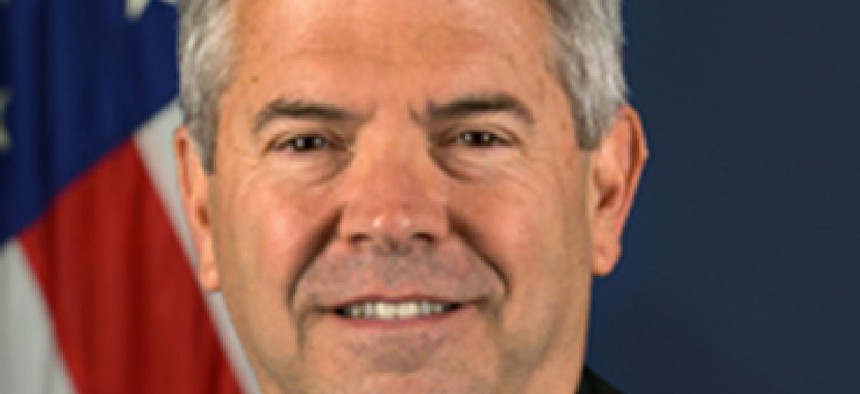DOT CIO on cyber, shared services and 'technology that is changing constantly'

Transportation Department CIO Richard McKinney says striking a balance between centralized and decentralized IT is one of his greatest challenges.

Transportation Department CIO Richard McKinney says striking a balance between centralized and decentralized IT remains one of the greatest challenges.
Department of Transportation CIO Richard McKinney thinks a lot about keeping his agency’s technology current.
DOT, after all, is one of the departments tasked with safeguarding the nation’s infrastructure. So in his first year on the job, McKinney has made cybersecurity a priority, opened up massive amounts of data and named an agency chief data officer.
He also has pushed to cultivate an agile workforce at DOT and across government, as part of his role as co-chair of the CIO Council’s Subcommittee on the Workforce.
McKinney sat down with FCW to talk about the learning curve at a large and federated agency, the challenges he foresees and what he hopes to accomplish with DOT technology.
Q: What have been some of your top priorities for the department?
A: From day one I have focused on cybersecurity as a top priority. We have concentrated on the basics, and as a result have made great progress in strengthening our cybersecurity posture.
Q: How hard is it to balance being compliant with being effective?
A: You should always lead with being effective. IT organizations that focus on effectiveness, on operational and process excellence, in doing so lay the essential groundwork that makes the tangential goal of full compliance more readily attainable.
Q: What do you see as some of the biggest IT challenges facing the Transportation Department?
A: We decided that we needed to find a balance between centralized and decentralized IT. We had to make sure that everyone had a seat at the table and a vote, to ensure that the shared service model met both the overall enterprise needs and the needs of each individual operating administration within DOT. We now meet with modal CIOs twice a month. Those meetings are very open, very structured, very collaborative and, I believe, very effective.
Q: What have you and your team done to prepare the department for the FedRAMP deadline?
A: One of the first questions people asked me when I came in was “how are you going to get DOT to the cloud?” After sitting and talking to the team at FAA, who were already in the process of creating and issuing a cloud contract, we made the strategic decision to expand the contract, to include all of the operating administrations in DOT. The OAs worked together to refine the solicitation so the contract would be able to meet the needs of all the OAs. It’s out on the street and it includes FedRAMP requirements. For the cloud initiatives that are already underway, we are working toward compliance and are engaged with third party assessors.
Q: How much have you used PortfolioStat and how useful has it been in helping to track IT spending?
A: PortfolioStat has provided an increased focus on efficiency. When OMB focuses on something, it adds weight. I think we had the mechanisms in place to do IT spend tracking before PortfolioStat, but it has provided a specific focus from the administration toward reducing duplication. That focus, coupled with our renewed focus on IT governance, has allowed us to transition some decentralized solutions to enterprise solutions.
Q: What do you see as some of the greatest IT challenges facing government?
A: A major challenge in government IT is ensuring we remain current with emerging technology that is changing constantly. This environment requires an agile workforce that can adapt to requirements and capabilities that change based on available technology solutions. In government, we have to ensure we’ve allotted the necessary resources to train our teams, and we need to ensure we have the right balance of contract and federal employees.
Q: What are your goals for the Subcommittee on Workforce for the CIO Council? What have the main discussions been in the subcommittee so far?
A: Darren Ash, CIO from the Nuclear Regulatory Commission and co-chair of the subcommittee, and I are fostering in-depth discussions between OPM, the Chief Human Capital Officers community and the CIO community to iron out differences in the interpretation of IT authorities and OPM hiring regulations as you move from department to department. We’re already making progress. One of the ideas we’ve come up with is building a library of position descriptions to share between departments. In other words, if one department writes a position description and it results in finding a well-matched candidate, we’re going to make that available so other departments can access it and tweak it for their use, as opposed to starting from scratch. That’s just a beginning, but it’s a good start.
Q: What should we expect to see coming out of DOT in the next six to 12 months?
A: Safety is the heart of the mission. To that end, we have an incredible amount of data that helps us track and fulfill that mission. We have been a leader in the federal government in opening up our data for public access, having already published over 2,000 data sets. We want to continue this approach and continue to expand our focus on our data because we understand that data is the lifeblood of that mission. To that end, we’ve recently appointed a chief data officer to help us coordinate our data sharing and analysis efforts. The department can also play a role in data standardization as we move into the Internet of Things, which for our department includes connected vehicles -- vehicle to vehicle, vehicle to infrastructure and vehicle to pedestrian. The digital world of transportation is really in its infancy, and DOT has a leadership role to play along with our state, local, and industry partners, to standardize data collection and data elements for the benefit of all.
NEXT STORY: DEA probes geospatial cloud





